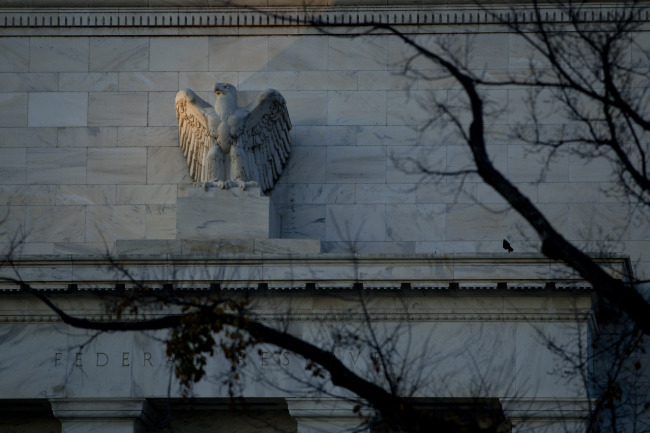Federal Reserve Bank of San Francisco President John Williams, who will vote on policy this year, said raising interest rates in June would be a close call amid “strong momentum” in the labor market and weaker wage gains.
“I would expect by June that the argument pro and con for lifting off rates will be probably a close call” assuming that inflation doesn’t fall further, Williams said Monday in a telephone interview from his San Francisco office. “It’s a reasonable guess.”
His remarks dovetailed with earlier comments from Atlanta Fed chief Dennis Lockhart, also a voting member of the policy-setting Federal Open Market Committee this year, that rate liftoff in mid-2015 would probably be justified.
U.S. stocks extended declines on the comments by Williams before markets closed in New York. The Standard & Poor’s 500 Index ended 0.8 percent lower at 2,028.26.
Fed Chair Janet Yellen told reporters last month not to expect the central bank to raise rates before the end of April, leaving expectations intact for a move around mid-year following sustained labor market improvements. The FOMC statement pledged a patient approach to monetary policy.
She also said officials would want to be confident that inflation was on track to head back up toward the Fed’s 2 percent goal before raising rates for the first time since 2006.
“I would expect by June that the argument pro and con for lifting off rates will be probably a close call” assuming that inflation doesn’t fall further, Williams said Monday in a telephone interview from his San Francisco office. “It’s a reasonable guess.”
His remarks dovetailed with earlier comments from Atlanta Fed chief Dennis Lockhart, also a voting member of the policy-setting Federal Open Market Committee this year, that rate liftoff in mid-2015 would probably be justified.
U.S. stocks extended declines on the comments by Williams before markets closed in New York. The Standard & Poor’s 500 Index ended 0.8 percent lower at 2,028.26.
Fed Chair Janet Yellen told reporters last month not to expect the central bank to raise rates before the end of April, leaving expectations intact for a move around mid-year following sustained labor market improvements. The FOMC statement pledged a patient approach to monetary policy.
She also said officials would want to be confident that inflation was on track to head back up toward the Fed’s 2 percent goal before raising rates for the first time since 2006.

Labor Department data last week showed the jobless rate fell to a six-year low of 5.6 percent even as hourly earnings dropped by 0.2 percent in December from the prior month, the biggest comparable decline since records began in 2006.
Williams said the report shows “significant employment gains” are continuing in the U.S. as it makes progress toward full employment, which he expects to reach by the end of this year or early in 2016.
“On the other side, the wage and price data are still soft, so in terms of thinking about June my views haven’t really changed,” Williams said. “If inflation data come in significantly softer than expected and we’re not seeing some kind of better growth in wages, those are clearly factors that I’d be taking into consideration in the timing of liftoff.”
The Fed’s main gauge of prices, the personal consumption expenditures index, hasn’t exceeded the central bank’s 2 percent objective since March 2012. It has slowed in recent months to a pace of 1.2 percent in November from a year earlier.
The FOMC will next meet Jan. 27-28 in Washington. Fifteen of 17 officials have said they expect the federal funds rate will rise this year after remaining near zero since December 2008.
Lockhart said in a speech in Atlanta Monday that policy makers should take a “cautious and conservative” approach as they move toward starting to raise interest rates around the middle of this year.
Echoing his colleague on the need to weigh incoming economic data, Williams said the recent news has been “mostly encouraging.” Gross domestic product in world’s largest economy expanded at a 5 percent annualized pace in the third quarter, the strongest in more than a decade.
“GDP growth has been well above trend and I expect it to be above trend in the fourth quarter,” Williams said. “I haven’t changed my fundamental view of the trajectory of the economy and if anything have gained more confidence on the maximum employment mandate.”
As the first rate rise nears, Williams said he will be watching for any “worrisome” downward shift in inflation or inflation expectations.
“I haven’t seen that yet,” Williams said, adding that Fed forecasts already account for declines in energy prices and the rising dollar.
Policy makers also don’t need to have 100 percent certainty that they have got the exact timing of rate rises correct, because they can always adjust policy as needed afterward, Williams said.
Placing heavy emphasis on the date of liftoff “suggests that you don’t have any other decisions to make,” Williams said. “We want to be very confident that we’re on the right path, that the data support that first move, but that first move on tightening is only one of many, many policy actions we’ll need to do during the normalization. It’s not the critical component.”
Williams, 52, joined the San Francisco Fed in 2002 and was director of research before being named president in March 2011. He succeeded Yellen as president of the regional Fed bank, one of 12 in the country. (Bloomberg)
-
Articles by Korea Herald




![[Herald Interview] 'Amid aging population, Korea to invite more young professionals from overseas'](http://res.heraldm.com/phpwas/restmb_idxmake.php?idx=644&simg=/content/image/2024/04/24/20240424050844_0.jpg&u=20240424200058)













![[KH Explains] Korean shipbuilding stocks rally: Real growth or bubble?](http://res.heraldm.com/phpwas/restmb_idxmake.php?idx=652&simg=/content/image/2024/04/25/20240425050656_0.jpg&u=)

